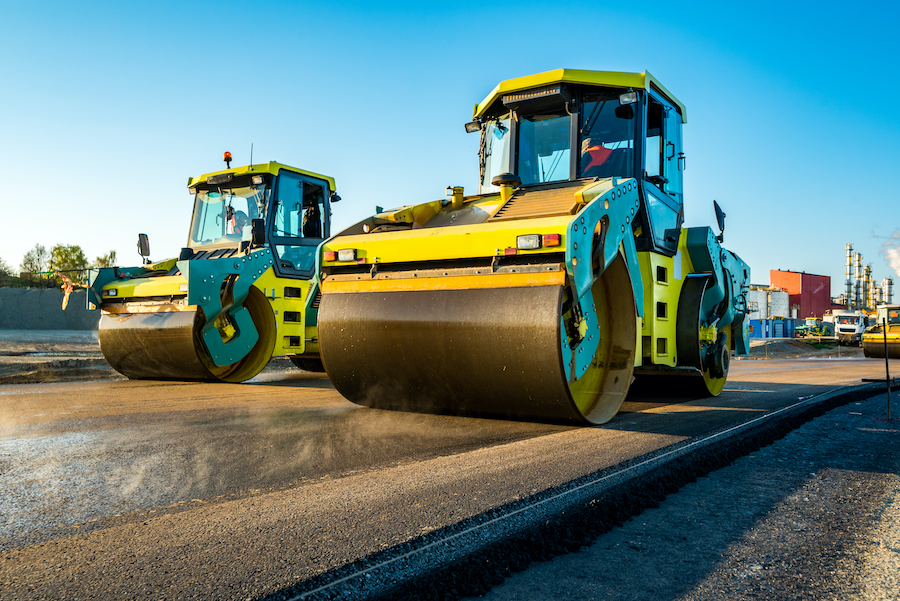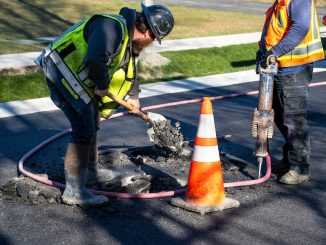
Our Asphalt Design Guide article series, based on the Asphalt Paving Design Guide by Minnesota Asphalt Pavement Association, will give you information about using asphalt in your construction projects. In our first article, we discussed the value of using asphalt. In this article we discuss design considerations such as traffic, soil support capability, and pavement thickness.
Design Fundamentals
Many types of asphalt pavement structures exist, along with a number of different methods for designing the thickness of each element in any pavement. Fundamental to the design of each project are the following:
- Traffic loading (volume and type).
- Soil-support capability (including drainage considerations).
- Material specifications (aggregate and asphalt), including thickness design.
Each element is an important variable in the structural design process. The economic life of the final product depends on the close attention given to detail when analyzing traffic loadings, soil-support capability, and material specifications.
The degree of detail needed in a specific design situation is related to the type of use intended for the pavement and the sensitivity of each variable. For example, a freeway design with large traffic volumes and heavily loaded trucks requires a careful estimate of traffic. However, for design of a bicycle path, the number of bicycles using the facility is likely not as important a design factor as soil-support capability.
Traffic
The loading on a pavement is the traffic. The primary function of the pavement is to transmit and distribute the wheel loads to the supporting subgrade. The total effect of the traffic is related to the number and size of the wheel loads. Traffic is composed of axle load applications of various weights and configurations. There are single, tandem, and multiple axles with loads ranging from 2,000 pounds up to 50,000 pounds. Tandem and multiple axles can reduce the load effect on a pavement. Therefore, the volume and distribution of vehicle types is especially important to estimate the pavement’s anticipated life.
Traffic predictions are based on: (1) historic records of traffic volumes on comparable roads or facilities and, (2) the percentage of trucks.
The first parameter needed to estimate the traffic effect is the total volume in terms of two-way Average Daily Traffic (ADT). ADT can be measured using a pneumatic tube over a number of days or estimated from a traffic map for a similar road. For design purposes the measured values are converted to Annual Average Daily Traffic (AADT) using daily and seasonal factors specific to your area.
For example, for a roadway in Minnesota, the load effects of trucks as a percentage of overall ADT are predicted using either Heavy Commercial Average Daily Traffic (HCADT), or Equivalent Standard Axle Loads (ESALs). HCADT is defined as the number of vehicles with six or more tires predicted on the road 20 years into the future. ESALs are a measure of the accumulation of equivalent 18,000-lb single axles on the design lane over the design life (usually 20 years).
The effects of truck traffic on a pavement can be dramatic. Tests have shown that a single-unit, fully loaded, 80,000-pound truck can cause pavement damage equivalent to that caused by 6,000 automobiles. Careful estimates of expected traffic distribution must therefore be made for proper pavement design.
Soil Support Capability
The ability of the subgrade to support loads transmitted from the pavement is one of the most important factors in determining pavement thickness.
In street and highway construction, the subgrade provides the foundation for the pavement. Different types of soils have different abilities to provide support. A sandy soil, for example, will support greater loads without deformation than a silty clay soil. Thus, for any given traffic volume and weight of vehicles using the roadway, a greater pavement thickness must be provided on clay soils than on sandy soils.

Soil Texture
The soil texture refers to the relative size of the mineral particles, and is an important characteristic, as it limits and defines the soil’s uses. Most natural soil types are comprised of a combination of many particle sizes. The distribution of these sizes gives the soil a distinctive appearance, which is called texture, and is the term most often used to identify a soil.
There are three main textural classes: coarse or light grained soils, medium grained, and fine or heavy-textured soils. These may also be characterized as gravels, sands, and silts or clays.
Laboratory Determination of Soil Texture
To separate the soil particles by size, a gradation analysis is performed by running the soil sample through a series of sieves. The portion passing or retained on each sieve is measured, and expressed as a percentage. The percentages of smaller size particles which pass the No. 200 sieve are determined by hydrometer analysis, which determines the soil size based on its settling velocity.
Once the percentage of each particle size in the sample is known, the soil can be assigned a textural classification dependent upon the amounts of sand, clay and silt present. Stone and gravel particles larger than the sand size (No. 10 sieve) do not have much effect on the basic soil classification. Soils containing more than 25 percent gravel particles are generally termed gravelly or stony soils.
Pavement Thickness Design
Calculations regarding pavement thickness are critical to a cost-effective project. If pavements are thicker than required, then excess dollars are spent on materials and labor that could be better spent elsewhere. If pavements are too thin to support actual traffic, then pavements fail before their anticipated useful life is over.
Pavement thickness design consists of determining the total thickness of pavement required above the subgrade, as well as the various thicknesses of each of the pavement components for traffic and subgrade conditions. Structural designs are based upon the cumulative damaging effect of traffic over a design period (usually 20 years). Traffic calculations are outlined in a preceding section of this chapter.
Thickness Design and Subgrade Strength
Because thickness calculations depend on the strength of the finished subgrade, the soil must be tested to determine this information. Tests are based on bearing capacity related to the moisture and density of the soil. The California Bearing Ratio (CBR) is one of the most widely used methods of designing pavement structure. Once the CBR value is determined, the soil classification can be identified, conversely, when the soil classification is known, a relative CBR value can be identified.
Another soil strength indicator is the R-value, also known as the “resistance value” or stabilometer strength of a soil. A soil’s R-value indicates its resistance to deformation.
Soil Testing
A qualified laboratory can conduct tests to provide soil classification and subgrade strength information, such as a design R-value. Such testing is necessary to ensure a proper structural design and should be part of all major pavement design projects.
Field Compaction Assessment
A simple test is available for determining in-place compaction. The Dynamic Cone Penetrometer (DCP). The DCP is an inexpensive and easily transportable tool.
The DCP consists of two 16 mm rods coupled at midpoint. The lower rod contains an anvil and a pointed tip, which is driven into the ground by dropping a hammer contained on the upper rod onto the anvil. The underlying soil strength is determined by measuring the penetration of the lower shaft into the soil after each hammer drop. Stiffer or stronger soils have a lower DPI. The DPI is used to identify pavement layer boundaries, determine material layer strengths, or estimate overall strength of the unbound materials.
Subgrade Classes
For the designs recommended in this manual, all soils have been divided into three classes: good (G), moderate (M), and poor (P). Design R-values have been assigned to these different subgrade classes.
Good
Good subgrade soils retain a substantial amount of their load-supporting capacity when wet. Included are the clean sands, sand-gravels, and those free of detrimental amounts of plastic soils. Good subgrade soils are relatively unaffected by moisture or frost and contain less than 15 percent passing a No. 200 sieve. A soil classified as “good” will have an R-value of 50 or higher.
Moderate
Moderate subgrade soils are those that retain a moderate degree of firmness under adverse moisture conditions. Included are such soils as loams, silty sands, and sand gravels containing moderate amounts of clays and fine silts. A soil classified as “moderate” will have an R-value of 15-50.
Poor
Poor subgrade soils are those that become quite soft and plastic when wet. Included are those soils having appreciable amounts of clay and fine silt (50 percent or more). The coarse silts and sandy loams may also exhibit poor bearing properties as the result of frost penetration into the subgrade. This also is true where the water table rises close to the pavement surface. A soil classified as poor will have an R-value less than 15.
Subgrade Stabilization
Extremely poor soils can be stabilized with granular material, a geotextile, or additives such as lime, fly-ash, asphalt cement, Portland cement, and combinations of cement stabilizers to improve subgrade support characteristics. The selection of a stabilizing agent, the amount to use, and the application procedure depend on the soil classification and the subgrade-support value desired. These should be determined through appropriate laboratory testing.

Other Considerations
Drainage
Subsurface water is free water that percolates through, or is contained in, the soil beneath the pavement surface. When it emerges or escapes from the soil, it is referred to as seepage water, and the point of emergence is called a seepage area or a spring. Since the presence of water reduces the strength of the pavement structure, it is important to remove subsurface water from the pavement structure.
Water may rise from the underlying soil through the subgrade and into the pavement structure. This free water could move readily into an aggregate base layer to a low point on the profile. If steep grades are present, and the subsurface water flowing in an aggregate base to the low spot is not intercepted, a hydrostatic head may result, causing pavement distress. Water in the pavement courses also may contribute to the stripping of asphalt films from the aggregate particles.
Subdrains
Subdrains are required when water collects in the pavement structure. Identification of these areas and determination of drain locations requires the technical expertise and insight of an engineer. The choice of drain filter material and the design of the drainage system must be given careful attention by experts. Perforated and slotted pipe can be used to move the free water from the trouble spot to a drainage area.
Subgrade drains should be considered whenever the following conditions exist:
- high groundwater levels, which may reduce subgrade stability and provide a source of water for frost action
- silty or very fine sand subgrade soil, which may become quick or spongy when saturated
- water seeping from underlying water-bearing strata
- cuts in terrain that intercept the natural drainage path of higher elevations
- sag curves with low-permeability subgrade soils
In general, drains should not be located too close to the pavement (to prevent damage to one when working on the other), and some provision should be made to prevent the infiltration of silt and fines into the drain. Geotextile sleeves may be placed around the drains for this purpose.
The Use of Geofabrics in an Asphalt Pavement Section
Geofabrics have been used in asphalt pavement sections for many years primarily as a separation layer between fine-grained subgrade soils and granular subbase or base layers. Geofabric is the most effective solution to use when the soil is at or near saturation and the pumping action of traffic will tend to cause contamination of the granular layer.
Check Drainage During Construction
Regardless of the care used in the preliminary investigation, the soil survey, and the pavement structure design, it is usually impossible to determine from soil borings the exact elevation of water-bearing strata or the rate of flow that will develop. For this reason, a careful designer will reevaluate conditions and check the need for, and adequacy of, subsurface drainage indicated on plans.
Observe Soil Conditions
Soil conditions should be observed during the grading and subgrade preparation work. Any wet, soft, or spongy areas encountered during grading should be investigated and provisions made for their proper drainage. Even a minor rate of seepage may build up to a large quantity of water over a period of time if the water is not allowed to escape. Soft spots will often cause structural failure soon after traffic is allowed to use the new facility, and must be repaired before paving. After the pavement is in place, any corrective measures needed will be costly, create traffic problems, and cause poor public relations.
Test Areas of Subgrade
Areas of the subgrade that are anticipated for asphalt paving may be tested for uniformity and adequacy of support by driving a loaded dump truck at a speed of 2 to 3 mph over the entire surface. Areas that show a deflection of one or more inches should be further improved with an additional thickness of asphalt pavement. When the improvement is completed, the finished grade should be hard, stable and constructed in reasonably close conformance with the lines, grades and proposed typical cross sections. This will provide a working platform for paving construction equipment and associated activities. This process can also be used to evaluate the stability of aggregate base; however, the deflection should be minimal.
Conclusion
There are many things to consider that impact your final asphalt paving design. You must estimate the amount of traffic and the types of vehicles the asphalt must support today and at least 20 years into the future. The soil underneath the pavement must be able to support the asphalt and the anticipated level of use. Proper subgrade stabilization, drainage, and pavement thickness are critical factors to the success of your asphalt pavement design. In the next article in the Asphalt Paving Design series we discuss parking lot design.
How is traffic considered in asphalt paving design?
Traffic is a crucial factor in asphalt paving design, involving considerations of volume, types of vehicles, and load distribution, impacting the pavement's anticipated lifespan.
Why is soil support capability important in asphalt pavement design?
Soil support capability, determined by the subgrade's ability to bear loads, is vital for deciding pavement thickness, ensuring proper structural design, and avoiding premature pavement failure.













































